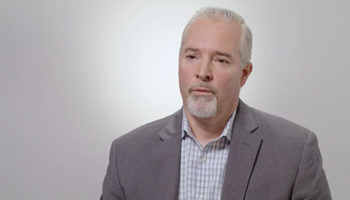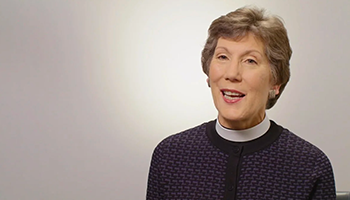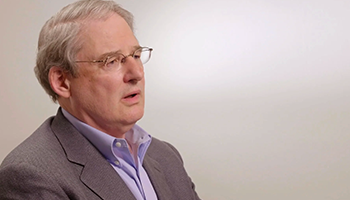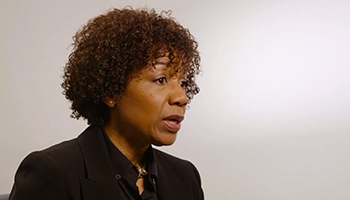
A Message from Mary Kate Wold
Dear Friends:
The Church Pension Group (CPG) marked its 100th year of service to the Episcopal Church in 2017. This milestone anniversary was a great opportunity to reflect on our vision, commitments, and relationships around the Church. We attended conferences and revivals. We conducted focus groups and interviews with clergy, lay employees, and administrators. We convened discussions on key topics of interest. We talked to industry experts, undertook surveys, and studied all of the rich demographic data we have at our disposal. We shared important conclusions with partners around the Church via presentations, published reports, and one-on-one conversations. We listened, and we learned.
I was humbled by the generous expressions of gratitude that I heard from clergy and lay employees around the Church; it was good to hear time and again that we are making a difference in people’s lives and that we are getting the right things done. From time to time, I also heard questions regarding CPG’s relationship with the Church, CPG’s responsiveness to ever-changing client needs, and CPG’s commitment to Church values. My colleagues and I would like to address these questions in this follow-up Report to General Convention as our Perspective special edition for the 79th General Convention.
Frank Armstrong, our chief operating officer, talks about benefits policy and how it is shaped by insights gathered from our travels around the Church. Patty Favreau, our chief communications officer, describes some of the ways we connect with others in the Church and track trends. Roger Sayler, our chief investment officer, talks about our financial strength and investment program, and Anne Mallonee, our chief ecclesiastical officer, offers her perspective on how our work connects with the values of the Episcopal Church. These are some of the executives with whom I have the privilege of working at CPG. I hope you enjoy hearing from them, and we look forward to spending time with you in Austin.
For more than a century, CPG has worked with General Convention to support those who serve the Episcopal Church around the globe. We are excited about continuing our partnership and work in the century ahead.
Meet the CPG officers featured in our Report to General Convention.
CPG’s Relationship with the Church
100 Years of Partnership with General Convention

Mary Kate Wold and Barbara Creed, Former Chair of The Church Pension Fund Board of Trustees, join others in reflecting on 100 years of service to the Episcopal Church.
Ever since The Church Pension Fund (CPF) was established in 1913, we have had a special and enduring relationship with General Convention. Title I, Canon 8, as enacted and amended by General Convention, describes our principal work and the process for electing CPF trustees. Twenty-four of our 25 trustees are elected by General Convention, and legislation considered at General Convention informs our strategic priorities every triennium. It was General Convention that raised up the ministry of lay employees and voted overwhelmingly in favor of requiring pensions and health benefits for lay professionals as a matter of Canon law. The collaboration between CPG and General Convention is longstanding, necessary, and strong. It has helped the Church provide meaningful benefits and peace of mind to eligible clergy and lay employees, allowing them to focus on ministry throughout their lives.

Mary Kate Wold describes the history of the relationship between The Church Pension Fund and the Episcopal Church.

The Rev. Thomas Brown, Chair of The Church Pension Fund Board of Trustees, discusses the responsibilities of the Board.
At the same time, CPF is separately incorporated in the State of New York with legal obligations at the state and federal levels that protect those we serve. For example, every officer and trustee of CPF has legal duties—called “fiduciary duties”—to act in the best interest of the benefit plans we administer. In other words, we cannot make decisions that adversely impact our investment portfolio or our ability to provide for those we serve. While our fiduciary duties put guardrails around what we are able to do with the assets entrusted to CPF, they also keep us focused on our purpose, which is a very good thing.
CPG’s Responsiveness to Client Needs
A Vision Based on Insights and Built on Financial Strength
Our vision is to provide our clients with the highest possible level of financial security in retirement that is consistent with exemplary financial stewardship on our part and with the evolving needs of the Church. Achieving this vision requires us to be in regular contact with our clients, to pay constant attention to emerging needs, to change benefits and programs when change is needed and affordable, and to do everything within our power to protect the financial strength of CPG.

Patty Favreau provides details on the Church Pension Group’s Insights & Ideas: Centennial Conversations.
Major changes in clergy deployment patterns over the past several years drove us to consider revising The Church Pension Fund Clergy Pension Plan (Clergy Pension Plan) and related plans, and we were glad to receive General Convention’s support of our work in 2015. Resolution 2015-A177 asked us to continue our work on revising benefits to suit changing ministries. A revised Clergy Pension Plan and related plans were launched in January 2018 with the flexibility, consistency, and relative simplicity we all need to respond to evolving needs.

Frank Armstrong describes how insights inform changes to benefits, including recent revisions to the Clergy Pension Plan and related plans.
Over the past triennium, we also have studied compensation and benefits in non-domestic dioceses to better understand the adequacy of benefits we offer in those regions. Our focus here is not new. In the past, we have adjusted the pension formula for clergy who participate in our International Clergy Pension Plan; created emergency funds that address urgent, unexpected financial need; hosted conferences and conversations to make sure our clients outside of the United States understand their benefits and know that we are here to support them; and established a dedicated resource for benefit administrators to escalate service issues that need extra attention. We are focused on the needs of clergy both inside and outside of the United States, but General Convention Resolution 2015-A181 gave us an opportunity to take another deep look at compensation and benefits, and we learned a great deal.
We learned that in many cases, our International Clergy Pension Plan offers higher income replacement levels to clergy than other pension plans in the region and in the United States. We also confirmed that the clergy life insurance and disability benefits we offer are more robust than benefits offered to similar workers in their locations. On the other hand, we identified lower levels of compensation and health benefits that result in additional financial strain. The results of our study have been shared with the CPF Board of Trustees and with each of the dioceses studied. They have also been published on our website and publicized by a press release. We hope you will read and share both.
We are in the process of studying lay employee retirement readiness. Our data, surveys, and focus groups tell us that major strides have been made since the Lay Pension System was established in 2009, but we know we have more work to do to help lay employees gain confidence in their retirement. Our research will help guide our work.
On an ongoing basis, CPG collects insights, considers the adequacy of benefits, and monitors the financial strength of CPF to make sure we can afford our commitments as well as whatever changes we contemplate. Some people ask why we need the amount of money we have and the investment returns we target. The answer is quite simple: we need these assets and returns in order to maintain a high level of confidence that we will be able to keep our commitments for as long as the Church needs us to keep them.
Shared Values. Distinct Mission.
The Most Rev. Michael Curry describes the Church as the Episcopal branch of the Jesus Movement—a movement grounded in love for the other and focused on three priorities: Evangelism, Reconciliation, and Creation Care. We share the same priorities in our work.
At the most fundamental level, CPG exists to support the clergy and lay employees of the Episcopal Church in their calling to spread the gospel. Our very mission supports evangelism. We also work on reconciliation and creation care at CPG. We engage regularly in conversations and work to develop our diversity and inclusion. For example, at a recent all-employee meeting, we invited Dr. Catherine Meeks to talk about race reconciliation, and we made her wonderful book available to all employees to encourage conversations. It was a huge success, and the conversations continue to this day.
Similarly, our work environment follows best practices of sustainability. Our home office in New York City was redesigned using sustainable materials and is LEED Gold Certified. And we have reduced paper and energy usage dramatically by adopting “green” ways of working. Our day-to-day practices support the Jesus Movement.
Church Publishing Incorporated, our publishing company, creates content in support of evangelism, reconciliation, and creation care. It has published a number of periodicals that support the Jesus Movement, which are available at www.churchpublishing.org/thejesusmovement.
Finally, our investment team has done outstanding work as a positive impact investor and active shareholder. While the primary responsibility of the investment team is to ensure that we have enough money to pay benefits for as long as our clients need them, we are also constantly looking for opportunities to earn strong returns while having a positive social impact. Our investments have funded sustainable energy projects and helped to improve the quality of life in economically challenged communities in the United States and around the world. They have planted seeds for economic development in emerging markets and brought vitality and commerce to urban centers in need of revival. We are making a difference in people’s lives while earning the strong returns we need to meet client needs over time.

Mary Kate Wold describes how The Church Pension Fund lives the values of the Church in its work and its investment activity.
The gospel of love of neighbor is expressing itself in Church-wide conversations about parity. Individuals have raised questions with us about different compensation patterns between men and women, individuals serving in non-domestic dioceses, clergy of color, and lay and clergy. We are glad to see the Church wrestling with these issues, and we are doing whatever we can do to collect and share the facts. For example, we have shared compensation data by gender in our annual Clergy Compensation report and in presentations we have made around the Church. We also have data on compensation in the non-domestic dioceses, which you can review in our response to General Convention Resolution 2015-A181.
While we have been asked for clergy compensation data by race, we do not actually collect this information. For privacy and certain legal reasons, CPG collects only the information we need to process the products we provide and race information is not needed to price or administer our benefits. Ordination officers already collect substantial demographic data, which they pass onto CPG in its role as Recorder of Ordinations. We have proposed that the ordination officers in each diocese leverage this existing ordination process and collect race information for clergy when other demographic information is collected. Ordination data is shared with the Recorder of Ordinations—currently CPF—and we would be happy to share it as it is provided to us.
We also have been asked whether we have considered moving to a pension plan design that “flattens out” the benefits paid to clergy regardless of their compensation during active service. Canon I.8, which governs our work, requires us to administer the Clergy Pension Plan in a manner that is consistent with its original intent. For the past 100 years the Clergy Pension Plan has followed a typical “income replacement” approach, with benefits reflecting in part the compensation clergy received while active. Moving to a different approach that “flattens out” benefits would be a marked departure from historical practice and the expectations of clergy and their employers. For those reasons, we would not consider such a move without strong indications from the General Convention that “flat” or “equal” pensions are the will of the Church at large. Resolution 2018-A060 lists equal pensions as a priority for study going forward.
Regarding lay pension benefits, we have been asked what would be necessary to achieve parity in retirement benefits between clergy and lay employees. CPG has been providing pension benefits to lay employees since 1980. In 2009, General Convention passed Resolution 2009-A138 that amended Canon I.8 to make pensions mandatory for lay employees who work at least 1,000 hours annually. Under the resolution, employers are required to contribute up to 9% of a lay employee’s compensation into a defined benefit plan or a defined contribution plan administered by us or otherwise permitted by the Canon. Participation in the lay pension system has been strong, and lay employee retirement savings have grown tremendously since 2009. However, clergy benefits and lay employee benefits are not equal. Achieving parity in retirement benefits between clergy and lay employees would require that all lay employees participate in our lay defined benefit plan and that the assessment rate be raised from the current 9% to 18%. Even then, it would take years for the assets of the lay defined benefit plan to grow sufficiently to afford the full menu of benefits offered by the Clergy Pension Plan and related plans. CPG is committed to serving lay employees in whatever ways we can, and we will look to General Convention for guidance on this.
You will be redirected to a new tab for live remote support. Please confirm you're on a call with a Client Services team member to continue.























